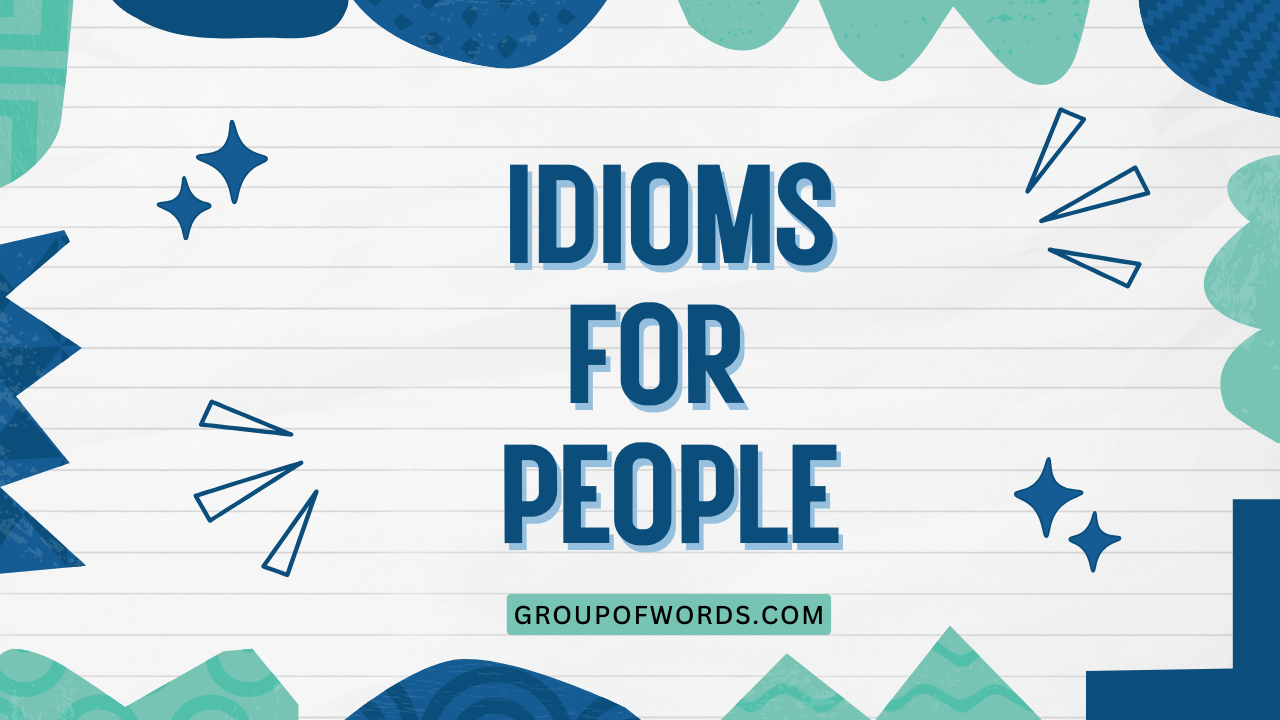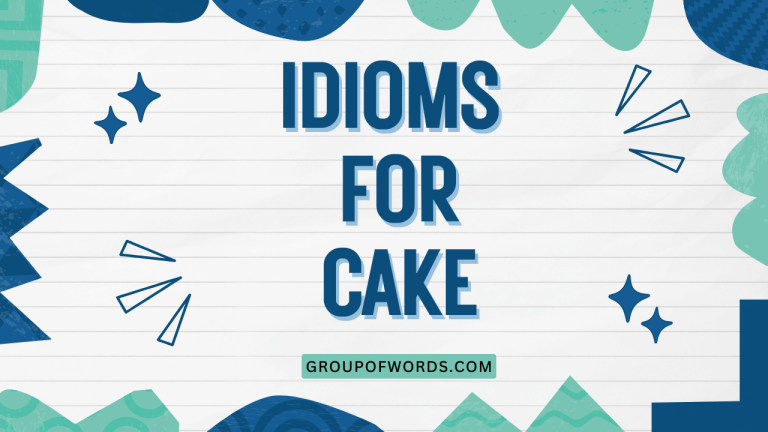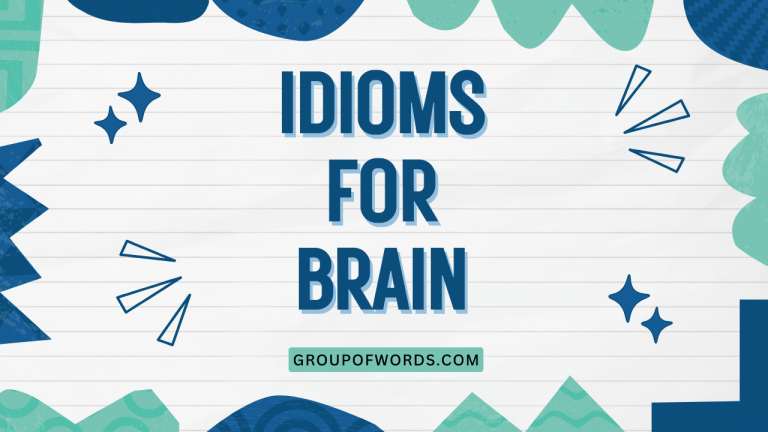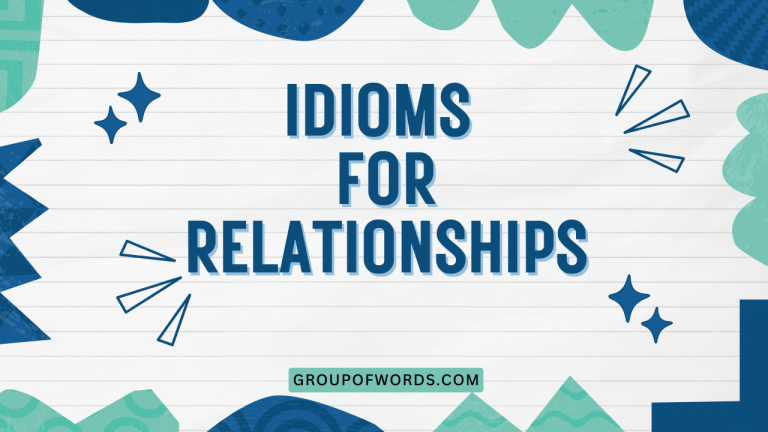Describing People: Mastering Idioms for Personality & Behavior
Idioms are a vibrant part of the English language, adding color and nuance to our conversations. When it comes to describing people, idioms offer a particularly rich palette.
Understanding these expressions is crucial for comprehending native speakers and expressing yourself more effectively. This article delves into the world of idioms used to describe personality traits, behaviors, and characteristics.
Whether you’re an English language learner or simply looking to expand your vocabulary, this guide will equip you with the knowledge and practice you need to confidently use idioms related to people.
This comprehensive exploration covers a wide range of idioms, providing clear definitions, examples, and usage tips. You’ll learn how to distinguish between similar idioms, avoid common mistakes, and practice using these expressions in various contexts.
By the end of this article, you’ll have a deeper understanding of how idioms shape our perception and description of individuals.
Table of Contents
- Definition of Idioms for People
- Structural Breakdown of Idioms
- Types and Categories of Idioms for People
- Examples of Idioms for People
- Usage Rules for Idioms
- Common Mistakes with Idioms
- Practice Exercises
- Advanced Topics in Idiom Usage
- Frequently Asked Questions
- Conclusion
Definition of Idioms for People
An idiom is a phrase or expression whose meaning cannot be understood from the literal meanings of its individual words. Instead, it has a figurative meaning that is known through common usage.
Idioms related to people are expressions used to describe someone’s personality, behavior, or characteristics in a colorful and often indirect way. These idioms provide insights into how we perceive and communicate about individuals, adding depth and nuance to our language.
Idioms can be classified based on their function and context. Some idioms describe positive traits, such as “heart of gold” or “life of the party.” Others describe negative traits, like “a wet blanket” or “a couch potato.” Still others are neutral, simply describing a person’s general demeanor or habits, such as “an early bird” or “a night owl.” Understanding these classifications helps in choosing the right idiom to convey the intended meaning.
The cultural context is crucial when using idioms. What might be a common and accepted expression in one culture could be confusing or even offensive in another.
Therefore, it’s important to be aware of the cultural implications and potential interpretations of idioms, especially when communicating with people from diverse backgrounds.
Structural Breakdown of Idioms
Idioms, by their very nature, defy straightforward structural analysis. Their meaning is not derived from the sum of their parts.
However, we can examine some common structural patterns found in idioms describing people.
Many idioms utilize metaphors, comparing a person’s traits to something else. For instance, “eagle-eyed” uses the metaphor of an eagle’s sharp vision to describe someone with keen observation skills. Similarly, “cold fish” uses the metaphor of a fish’s coldness to describe someone who is unemotional and aloof.
Some idioms involve similes, explicitly comparing a person to something using “like” or “as.” For example, “as busy as a bee” describes someone who is very active and industrious. While less common than metaphorical idioms, similes provide a direct and easily understandable comparison.
Other idioms may employ hyperbole, using exaggeration to emphasize a particular trait. For instance, “larger than life” describes someone with a flamboyant and captivating personality. The exaggeration highlights the person’s striking presence and impact.
Understanding these structural elements can help in deciphering the meaning of unfamiliar idioms. By recognizing the underlying metaphor or simile, one can often infer the intended meaning even without prior knowledge of the idiom.
Types and Categories of Idioms for People
Idioms used to describe people can be broadly categorized into three main types based on the connotation they carry: positive, negative, and neutral.
Positive Idioms
These idioms describe admirable qualities or behaviors. They are used to praise someone’s character or highlight their positive attributes.
Examples include “a heart of gold,” “a ray of sunshine,” and “a people person.”
Negative Idioms
These idioms describe undesirable qualities or behaviors. They are used to criticize someone’s character or highlight their negative attributes.
Examples include “a wet blanket,” “a couch potato,” and “a pain in the neck.”
Neutral Idioms
These idioms describe general characteristics or behaviors without necessarily implying a positive or negative judgment. They simply describe a person’s typical demeanor or habits.
Examples include “an early bird,” “a night owl,” and “a creature of habit.”
Examples of Idioms for People
This section provides extensive examples of idioms used to describe people, categorized by their connotation: positive, negative, and neutral.
Positive Idioms Examples
The following table provides examples of positive idioms, their meanings, and example sentences.
| Idiom | Meaning | Example Sentence |
|---|---|---|
| A heart of gold | A kind and generous person | She has a heart of gold and is always helping others. |
| A ray of sunshine | A cheerful and optimistic person | Her infectious laughter makes her a ray of sunshine in the office. |
| A people person | Someone who enjoys and is good at interacting with people | He’s a real people person and excels at building relationships. |
| The salt of the earth | A person of strong moral character; honest and reliable | My grandfather was the salt of the earth, always honest and hardworking. |
| A bright spark | An intelligent and quick-witted person | She’s a bright spark and quickly grasps new concepts. |
| Full of beans | Energetic and lively | The kids were full of beans after their nap. |
| A good egg | A kind and reliable person | Don’t worry, he’s a good egg; he’ll help you out. |
| A natural | Someone who is naturally skilled at something | She’s a natural on the piano; she picked it up so quickly. |
| On the ball | Alert, competent, and efficient | Our new project manager is really on the ball. |
| A whiz | Someone who is very skilled or knowledgeable in a particular area | He’s a whiz at computer programming. |
| A gem | A highly valued or cherished person | She’s a true gem; we’re lucky to have her on the team. |
| An angel | A very kind and helpful person | She’s been an angel, helping me through a difficult time. |
| A rock | Someone who provides unwavering support and stability | He’s been a rock for me since my father passed away. |
| A tower of strength | Someone who is strong and dependable, especially in difficult times | She’s been a tower of strength throughout the crisis. |
| A true blue | Loyal and faithful | He’s a true blue friend, always there when you need him. |
| A class act | Someone who behaves with grace, dignity, and style | She’s a class act, always polite and professional. |
| A smooth operator | Someone who is charming and persuasive | He’s a smooth operator and always gets what he wants. |
| A winner | Someone who is successful and accomplished | She’s a winner in everything she does. |
| A superstar | An exceptionally talented and successful person | He’s a superstar in the world of sports. |
| A legend | Someone who is famous and admired for their achievements | She’s a legend in the field of medicine. |
| A gift to | Someone who provides significant benefit to a group | His dedication to the community is a gift to this town. |
| A breath of fresh air | Someone who brings new ideas or energy to a situation | Her innovative approach is a breath of fresh air in the company. |
| The cream of the crop | The best of a group; the elite | These students are the cream of the crop. |
| A bright spark | Intelligent and quick witted | She is a bright spark and will do very well in her exams. |
| A dynamo | A very energetic and forceful person | She is a dynamo and gets so much done in a day. |
Negative Idioms Examples
The following table provides examples of negative idioms, their meanings, and example sentences.
| Idiom | Meaning | Example Sentence |
|---|---|---|
| A wet blanket | Someone who spoils the fun or enthusiasm of others | Don’t invite him; he’s a wet blanket and will ruin the party. |
| A couch potato | A lazy person who spends a lot of time sitting and watching television | He’s become a couch potato since he retired. |
| A pain in the neck | Someone who is annoying or troublesome | My little brother is a real pain in the neck. |
| A bad egg | A dishonest or unreliable person | I wouldn’t trust him; he’s a bad egg. |
| A loose cannon | Someone who is unpredictable and likely to cause trouble | He’s a loose cannon and you never know what he’s going to do next. |
| A control freak | Someone who tries to control everything and everyone | She’s such a control freak; she has to manage every detail. |
| A drama queen | Someone who exaggerates their emotions and reactions | She’s such a drama queen; she always makes a big deal out of everything. |
| A know-it-all | Someone who acts as if they know everything | He’s a know-it-all and always interrupts to correct people. |
| A busybody | Someone who interferes in other people’s affairs | She’s such a busybody; she’s always sticking her nose into other people’s business. |
| A rolling stone | Someone who doesn’t settle down in one place or job | He’s a rolling stone and has lived in many different countries. |
| A wolf in sheep’s clothing | Someone who appears harmless but is actually dangerous | He seemed so friendly, but he turned out to be a wolf in sheep’s clothing. |
| A snake in the grass | A treacherous or deceitful person | Beware of him; he’s a snake in the grass. |
| A penny pincher | Someone who is excessively frugal and unwilling to spend money | He’s such a penny pincher; he never buys anything new. |
| A Scrooge | A miserly person | Don’t expect a generous gift from him; he’s a real Scrooge. |
| A cheapskate | Someone who is unwilling to spend money | He’s such a cheapskate; he never pays for anything. |
| A blabbermouth | Someone who talks too much and reveals secrets | Don’t tell her anything confidential; she’s a blabbermouth. |
| A chatterbox | Someone who talks excessively | She’s such a chatterbox; she never stops talking. |
| A backseat driver | Someone who gives unwanted advice or instructions | I hate driving with him; he’s such a backseat driver. |
| A drama queen | Someone who exaggerates their reactions to events | She is such a drama queen, making a mountain out of a molehill. |
| A slacker | Someone who avoids work or effort | He is a slacker and never pulls his weight. |
| A fair-weather friend | Someone who is only a friend when things are going well | He is a fair-weather friend and disappears when things get tough. |
| A doubting Thomas | Someone who needs concrete proof before believing something | He is a doubting Thomas and will never believe you without evidence. |
| A stuffed shirt | Someone who is pompous and overly formal | He is a stuffed shirt and never relaxes. |
| A dark horse | Someone with hidden talents or abilities | He is a dark horse and could surprise everyone. |
| A yes-man | Someone who always agrees with their superior | He is a yes-man and never disagrees with his boss. |
| A wet blanket | Someone who spoils the fun | He’s a wet blanket and will ruin the party. |
Neutral Idioms Examples
The following table provides examples of neutral idioms, their meanings, and example sentences.
| Idiom | Meaning | Example Sentence |
|---|---|---|
| An early bird | Someone who wakes up or arrives early | She’s an early bird and always gets to the office before anyone else. |
| A night owl | Someone who stays up late at night | He’s a night owl and prefers to work late into the evening. |
| A creature of habit | Someone who follows a routine and dislikes change | He’s a creature of habit and always eats the same breakfast. |
| A lone wolf | Someone who prefers to be alone and independent | He’s a lone wolf and prefers to work on his own. |
| A social butterfly | Someone who is very social and enjoys attending parties | She’s a social butterfly and loves to mingle at events. |
| A workaholic | Someone who is addicted to work | He’s a workaholic and spends all his time at the office. |
| A bookworm | Someone who loves to read | She’s a bookworm and always has her nose in a book. |
| A daydreamer | Someone who spends time imagining things | He’s a daydreamer and often loses focus in class. |
| A homebody | Someone who enjoys spending time at home | She’s a homebody and prefers to stay in on weekends. |
| A fashionista | Someone who is very interested in fashion | She’s a fashionista and always wears the latest trends. |
| A trendsetter | Someone who starts new trends | She’s a trendsetter and everyone copies her style. |
| A go-getter | Someone who is ambitious and proactive | He’s a go-getter and always strives to achieve his goals. |
| A mover and shaker | An influential person who initiates events | She’s a mover and shaker in the political world. |
| A people watcher | Someone who enjoys observing people | He’s a people watcher and loves to sit in cafes and watch the world go by. |
| A free spirit | Someone who is independent and unconventional | She’s a free spirit and lives life on her own terms. |
| A wallflower | Someone who is shy and doesn’t participate in social activities | She was a wallflower at the party, staying in the corner and not talking to anyone. |
| A creature of comfort | Someone who enjoys comfort and luxury | He is a creature of comfort and loves staying in nice hotels. |
| A tough cookie | A person that is strong and determined | She is a tough cookie and can handle any challenge. |
| A happy camper | Someone who is content and satisfied | He’s a happy camper with his new job. |
| An old soul | Someone who seems wise beyond their years | She’s an old soul and gives great advice. |
| A rolling stone | Someone who doesn’t settle down | He is a rolling stone and has lived in several countries. |
| A square peg in a round hole | Someone who doesn’t fit in | He felt like a square peg in a round hole at his new school. |
| A dark horse | Someone who has hidden talents | She’s a dark horse and could surprise everyone. |
| A big fish in a small pond | Someone who is important in a small group | He’s a big fish in a small pond in his hometown. |
| A copy cat | Someone who copies others | She’s a copy cat and always copies my homework. |
Usage Rules for Idioms
Using idioms correctly involves understanding their specific meanings and contexts. While there are no strict grammatical rules governing idioms, certain guidelines can help ensure proper usage.
Context is key: Idioms are often context-dependent, meaning their appropriateness depends on the situation and audience. Avoid using idioms in formal settings or when communicating with people who may not be familiar with them. In these situations, clear and direct language is preferable.
Word order: The word order in an idiom is generally fixed. Changing the order can alter the meaning or make the idiom nonsensical. For example, saying “gold of a heart” instead of “a heart of gold” would not convey the intended meaning.
Tense and agreement: While the basic structure of an idiom is fixed, you can often change the tense or verb agreement to fit the context of your sentence. For example, you can say “She had a heart of gold” or “They are the salt of the earth.”
Overuse: Avoid overusing idioms, as it can make your speech sound unnatural or contrived. Use them sparingly and only when they add genuine value to your communication.
Cultural Sensitivity: Be aware of the cultural connotations of idioms from different regions and avoid using idioms that may be offensive or inappropriate in certain cultures.
Common Mistakes with Idioms
Using idioms incorrectly can lead to confusion or miscommunication. Here are some common mistakes to avoid:
- Literal interpretation: The most common mistake is interpreting an idiom literally, which can result in a nonsensical or humorous misunderstanding. For example, if someone is called “a couch potato,” it doesn’t mean they are literally a potato on a couch, but rather that they are lazy and spend a lot of time sitting and watching television.
- Incorrect word order: Changing the word order of an idiom can alter its meaning or render it incomprehensible.
Correct: He’s a pain in the neck.
Incorrect: He’s a neck in the pain.
- Mixing idioms: Combining parts of different idioms can create a confusing and awkward expression.
Correct: He’s burning the midnight oil.
Correct: He’s going the extra mile.
Incorrect: He’s burning the extra oil.
- Using idioms in inappropriate contexts: Using idioms in formal or professional settings may not be appropriate.
Appropriate (Informal): Let’s grab a bite to eat.
Inappropriate (Formal): We should convene for a repast at your earliest convenience.
- Using idioms out of cultural context: Using idioms that are specific to certain cultures can be confusing or offensive if the listener is not familiar with them.
Practice Exercises
Test your understanding of idioms for people with these exercises. Choose the correct idiom to complete each sentence.
| Question | Options | Answer |
|---|---|---|
| 1. She’s always so cheerful; she’s a real _____. | (a) wet blanket (b) ray of sunshine (c) couch potato | (b) ray of sunshine |
| 2. He never helps out; he’s such a _____. | (a) heart of gold (b) people person (c) slacker | (c) slacker |
| 3. She loves parties and meeting new people; she’s a _____. | (a) social butterfly (b) lone wolf (c) bookworm | (a) social butterfly |
| 4. He’s always interfering in other people’s business; he’s such a _____. | (a) bright spark (b) busybody (c) good egg | (b) busybody |
| 5. He’s so kind and generous; he has a _____. | (a) pain in the neck (b) heart of gold (c) loose cannon | (b) heart of gold |
| 6. He’s always up early; he’s an _____. | (a) night owl (b) early bird (c) rolling stone | (b) early bird |
| 7. She is so annoying; she is a _____. | (a) pain in the neck (b) heart of gold (c) ray of sunshine | (a) pain in the neck |
| 8. He is very strong and reliable; he is a _____. | (a) wet blanket (b) rock (c) social butterfly | (b) rock |
| 9. He never spends money; he is a _____. | (a) dynamo (b) cheapskate (c) angel | (b) cheapskate |
| 10. She loves reading; she is a _____. | (a) bookworm (b) early bird (c) couch potato | (a) bookworm |
Exercise 2: Fill in the blanks with the appropriate idiom from the list: couch potato, heart of gold, loose cannon, social butterfly, early bird, wet blanket, people person, know-it-all, rolling stone, dark horse
| Question | Answer |
|---|---|
| 1. Even though he didn’t seem like much at first, he turned out to be a real _____. | dark horse |
| 2. She’s a true _____, always attending parties and making new friends. | social butterfly |
| 3. He’s such a _____, always correcting everyone and acting like he knows everything. | know-it-all |
| 4. Despite his gruff exterior, he has a _____. | heart of gold |
| 5. She’s a _____, always spoiling the fun with her negativity. | wet blanket |
| 6. He’s an _____ and gets all his work done before anyone else arrives. | early bird |
| 7. He’s a _____ and you never know what he’s going to do next. | loose cannon |
| 8. She’s a real _____, always friendly and outgoing. | people person |
| 9. He’s a _____ and can never stay in one place for long. | rolling stone |
| 10. He’s such a _____, spending all his free time watching TV. | couch potato |
Advanced Topics in Idiom Usage
For advanced learners, understanding the nuances of idiom usage is crucial. This involves recognizing subtle variations in meaning, understanding the historical context of idioms, and using them effectively in sophisticated communication.
Idiomatic variation: Some idioms have slight variations in wording that can affect their meaning or impact. For example, “to bend over backwards” and “to go out of one’s way” both describe making an effort, but the former implies a greater degree of effort or sacrifice.
Historical context: Many idioms have historical origins that shed light on their meaning. Understanding the history behind an idiom can deepen your appreciation for its usage and cultural significance. For example, the idiom “raining cats and dogs” has several proposed origins, including the idea that during heavy storms, animals would sometimes be washed into the streets.
Creative idiom use: Advanced speakers can sometimes creatively adapt idioms to create new expressions or add humor to their communication. However, this should be done with caution, as it can easily lead to confusion if not executed skillfully.
Frequently Asked Questions
Here are some frequently asked questions about idioms for people:
- What is the difference between an idiom and a proverb?
An idiom is a phrase whose meaning is not deducible from the literal meanings of the words, while a proverb is a short, well-known saying that expresses a general truth or piece of advice. Idioms focus on figurative language, while proverbs offer wisdom or guidance.
- How can I learn more idioms?
Read widely, listen to native speakers, and use idiom dictionaries or online resources. Pay attention to how idioms are used in context and practice using them in your own speech and writing. Flashcards, apps, and language exchange partners can also be helpful.
- Is it okay to use idioms in formal writing?
Generally, it’s best to avoid idioms in formal writing, as they can sound too casual or informal. However, in some cases, a well-chosen idiom can add impact to your writing, but use them sparingly and consider your audience.
- Are idioms the same in all English-speaking countries?
No, idioms can vary significantly between different English-speaking countries and regions. What might be a common idiom in the United States could be unfamiliar or even confusing in the United Kingdom or Australia. Pay attention to regional variations and use idioms that are appropriate for your audience.
- How can I avoid misusing idioms?
Learn the precise meaning and usage of each idiom. Pay attention to the context in which it is used, and avoid making assumptions about its meaning based on the literal interpretation of the words. Practice using idioms in different contexts and get feedback from native speakers.
- What should I do if I don’t understand an idiom?
Ask for clarification. Don’t be afraid to ask the speaker to explain the meaning of the idiom. You can also look it up in an idiom dictionary or online resource. Understanding idioms is a continuous learning process.
- How can I teach idioms to English language learners?
Use visual aids, provide clear definitions and examples, and encourage learners to use idioms in context. Make learning fun and engaging by using games, activities, and real-life scenarios. Focus on commonly used idioms and gradually introduce more complex expressions.
- Are there any online resources for learning idioms?
Yes, many online resources are available for learning idioms, including idiom dictionaries, websites, and mobile apps. Some popular resources include The Free Dictionary, Merriam-Webster’s Learner’s Dictionary, and various language learning apps.
Conclusion
Mastering idioms for describing people is an essential step in achieving fluency and cultural competence in English. By understanding the definitions, structures, and usage rules of these expressions, you can communicate more effectively and expressively.
Remember to pay attention to context, avoid common mistakes, and practice using idioms in various situations.
Continuously expanding your knowledge of idioms will not only enhance your language skills but also deepen your understanding of English-speaking cultures. Embrace the challenge of learning new idioms and enjoy the richness and color they bring to your communication.
Keep practicing, and you’ll soon be using idioms like a native speaker, adding depth and nuance to your descriptions of people.






